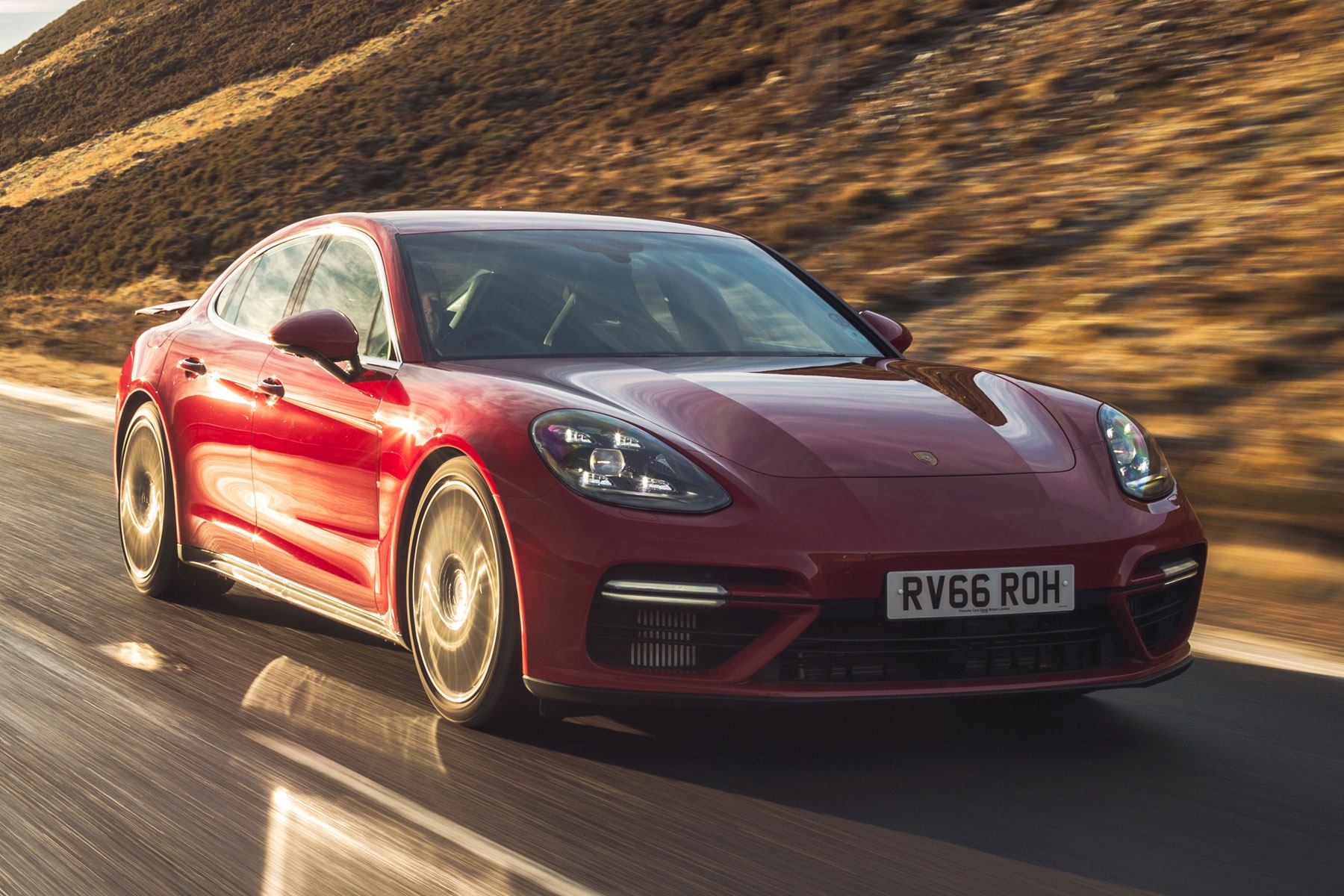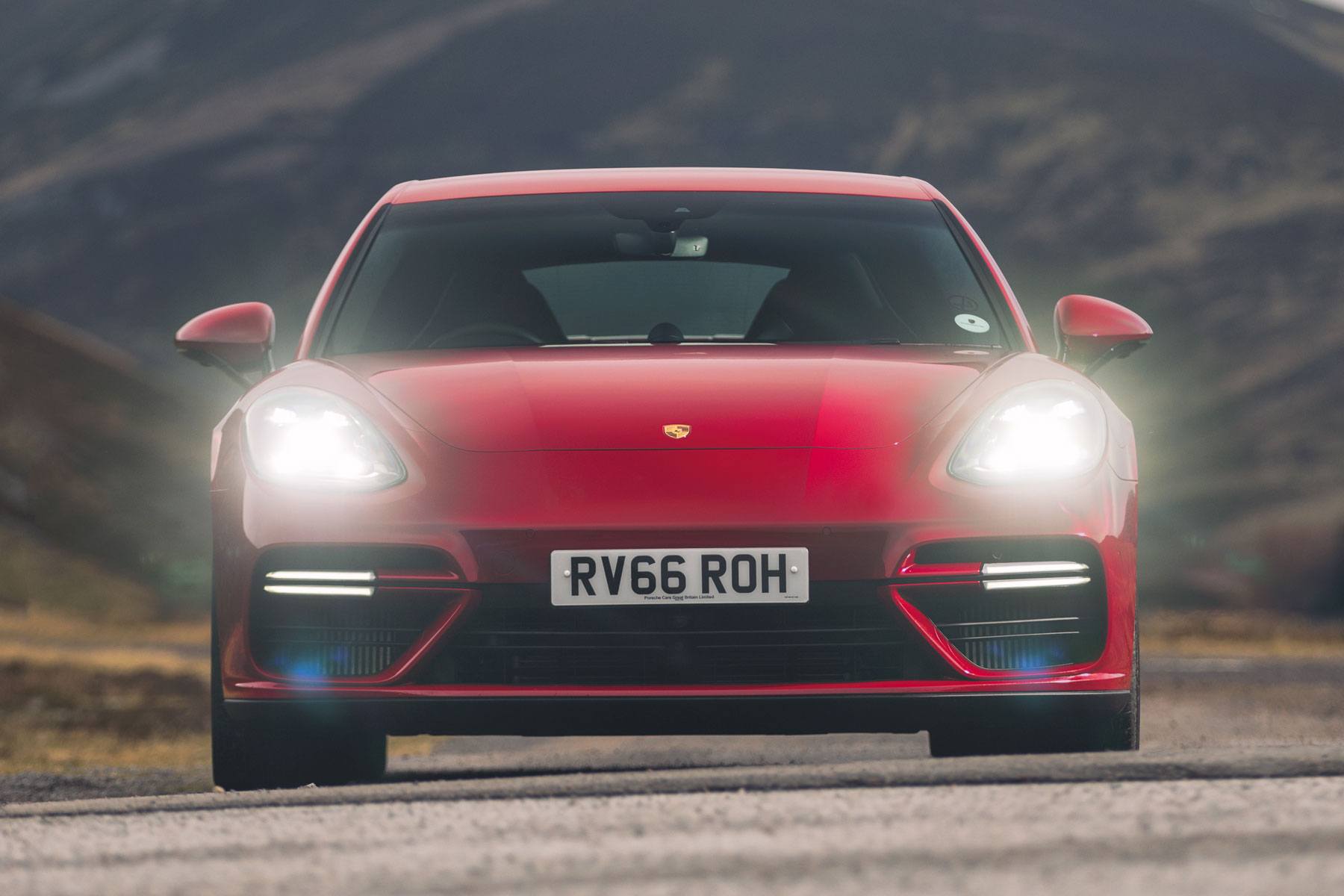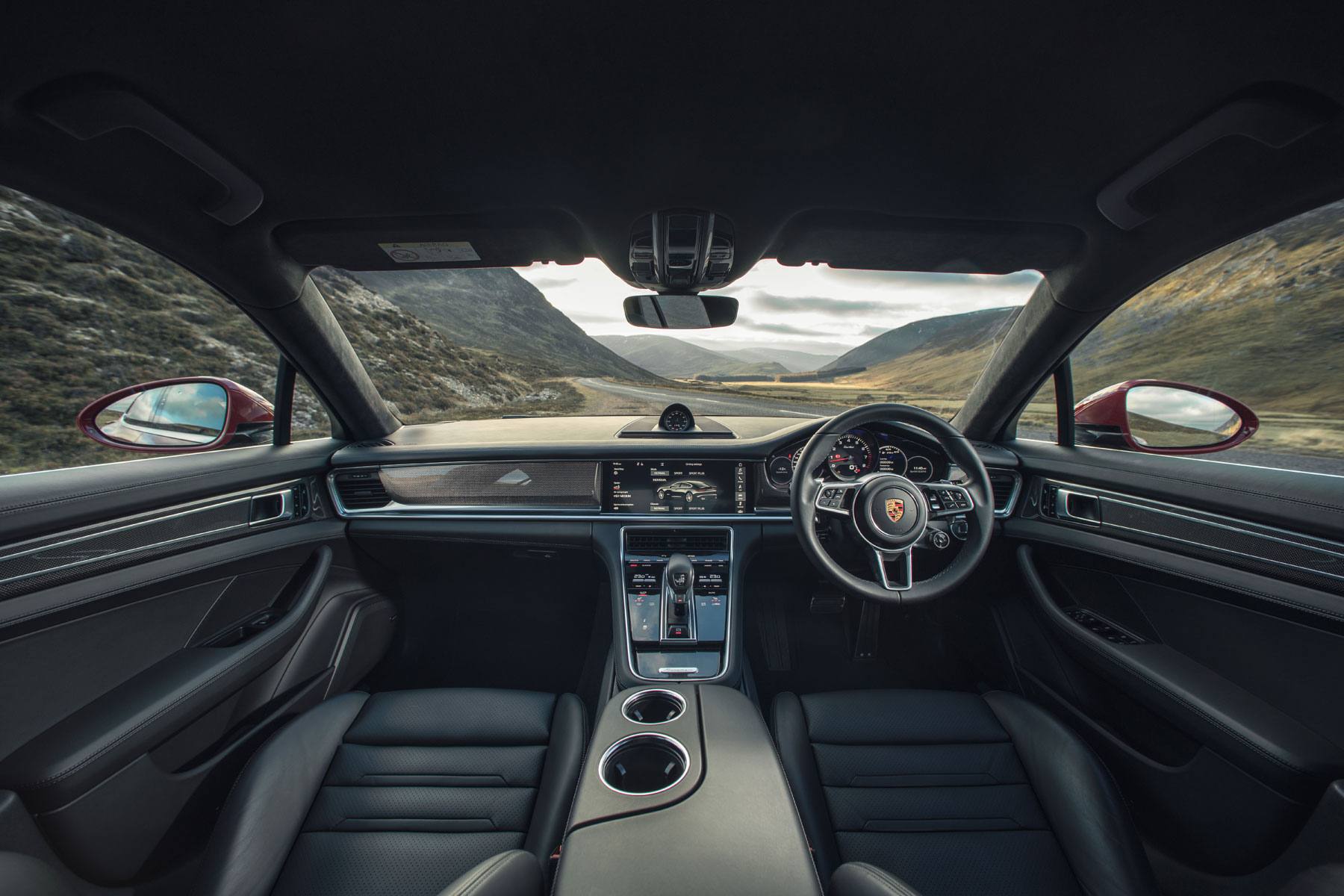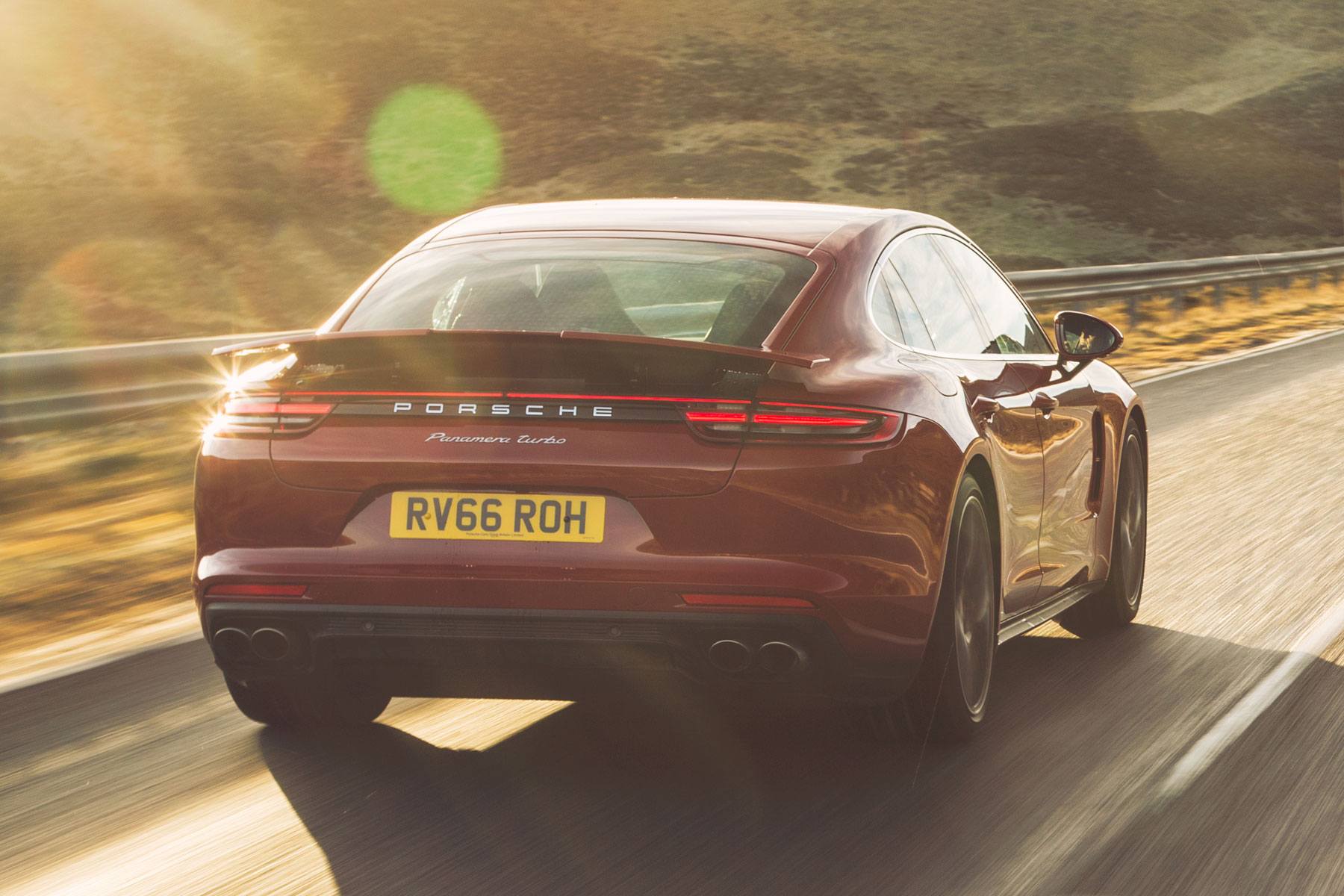Porsche Panamera Review
Porsche’s Panamera combines the poise and performance of a sportscar with luxury comfort and refinement. It’s not cheap, though.
Strengths & weaknesses
- Strong performance
- Good to drive
- Impressive comfort
- Expensive to buy
- Sport Turismo not as practical as you’d expect
- Bewildering line-up
The Porsche Panamera is a car of two halves, essentially aiming to be both a sharp driving sports saloon and a luxurious limousine. While that could be a recipe for a compromise that doesn’t quite work, the Panamera proves to be hugely adept at both tasks.
Prices range from £74,225 to an eye-watering £141,025 from new. Depending on model, the rivals are as diverse as the Mercedes S-Class, BMW M5 and Audi RS7.
There are three distinct bodystyles to choose from - Panamera, Panamera Executive and Panamera Sport Turismo. The former is the standard car and, for most, delivers all the space and versatility you’ll need. Unlike many saloon rivals the Panamera features a hatchback, boosting access to the 500-litre boot. That’s 10-litres down on a Mercedes S-Class, but the Porsche hits back with a 60/40 split and fold rear seat that can be lowered to extend the carrying capacity to an impressive 1,340-litres.
All versions of the Panamera have generous space for rear seat passengers, with even the standard car matching the likes of the Jaguar XJ. However, if you need even more room to lounge around in the Executive features a wheelbase that’s been stretched by a generous 150mm, meaning even more space to stretch.
Finally, there’s the Panamera Sport Turismo, which features an extended roofline to create something that’s as close to a Porsche estate car as you’ll ever get. That said, the gains are space are small, with the boot capacity increasing to 520-litres with the rear seats in place and 1,390-litres with them folded. By comparison, a Mercedes-AMG E63 S estate can accommodate 640 and 1,820-litres respectively. Bear in mind that there’s no more passenger space than the standard car either.
Regardless of bodystyle the interior of the Porsche Panamera is exceptionally well-finished and easily feels more special than cars from firms as upmarket as Audi, BMW and Mercedes. All the materials are of the highest quality, while the fit and finish are all first rate.
The Panamera doesn’t lack technology either, particularly when it comes to entertainment. The rev counter set directly in front of the driver is analogue, but either side of this are seven-inch, fully configurable screens that can show everything from performance data to sat-nav directions. Mounted high in the centre of the dashboard is a 12-inch touchscreen that controls most of the car’s major functions.
Euro NCAP hasn’t assessed the Panamera, but the Porsche feels extremely substantial and safe. Backing this sense of security up are 10 (yes, 10!) airbags, electronic stability control and a pair of ISOFIX child seat mounting points in the rear.
However, if you want the latest driver aids you’ll have to pay extra. That said, Porsche’s InnoDrive system is extremely sophisticated, linking the adaptive cruise control to GPS to control the car’s speed according to upcoming hazards and speed limits. It also includes Traffic Jam Assist, which takes control of the steering, brakes and throttle at speeds of up to 37mph.
Other hi-tech options include a night vision camera, head-up display and lane keep assist.
You sit low in the Porsche Panamera, making it feel more like a sportscar than a saloon. The seats are extremely comfortable and finding your perfect driving position is easy - few rivals cater so comprehensively for the driver.
It’s a sensation that’s backed up on the road, where even the most basic Panamera feels more composed and agile than rival fast saloons and limousines. The steering is accurate with just enough weight to give good feedback, while the four-wheel drive delivers confidence-inspiring traction that allows you to make the most of the car’s prodigious performance potential. And while the Panamera feels big at first, the excellent driving position, good visibility and responsive handling soon make you feel at ease and forget about the fact the car is over five metres long and nearly two metres wide.
Yet the Panamera’s party trick is that it combines this sportscar agility with comfort and refinement. With the standard adaptive suspension dampers set to their softest setting the Porsche soaks up bumpy roads - models fitted with air suspension are even more impressive in this regard. It’s quiet too, with low levels of wind and road noise. Not many cars are as adept at covering big distances with so little effort.
Key facts
| Warranty | 3 years / 60,000 miles |
|---|---|
| Boot size | 660 litres |
| Width | 1937mm |
| Length | 5049-5199mm |
| Height | 1423-1432mm |
| Tax (min to max) | £25 to £1760 in first year, £145 thereafter |
Best Porsche Panamera for...
Best for Economy – Porsche Panamera 4 E-Hybrid
This plug-in hybrid model has remarkable on paper figures, claiming up to 85.6mpg. Of course, you’ll need to keep it charged to achieve this
Best for Families – Porsche Panamera Turbo S E-Hybrid Sports Turismo
It’s not cheap, but Sport Turismo is spacious, while electric motors make it clean and cost effective for the school run
Best for Performance – Porsche Panamera GTS
For outright acceleration the Panamera Turbo S E-Hybrid wins, but the GTS is a more fun and engaging, plus it’s fast enough.
One to Avoid – Porsche Panamera Turbo
It’s a great car, but cheaper versions aren’t much slower, while E-Hybrids have efficiency and even greater performance.
History
Jun 2016 Porsche Panamera launched globally and at Goodwood Festival of Speed, with Panamera 4, 4S, 4S Diesel and Turbo models available
Sep 2016 Porsche Panamera 4 E-Hybrid joins line-up
Feb 2017 High performance Panamera Turbo S E-Hybrid hits showrooms
Mar 2017 The Porsche Panamera Sport Turismo is launched in 4, 4S, 4S Diesel and Turbo trims
Sep 2017 Practical Panamera Sport Turismo is now available as Turbo S E-Hybrid
Dec 2017 Panamera 4 E-Hybrid finally arrives in the UK
Sep 2018 Porsche drops the 4S Diesel from the range
Oct 2018 Performance focussed Panamera GTS and Panamera Sport Turismo GTS are revealed
Understanding Porsche Panamera names
Engine Turbo S E-Hybrid
The 4, 4 E-Hybrid, 4S, GTS, Turbo and Turbo S E-Hybrid designate what engine and power each model has. It looks like a lot, but essentially there are two basic turbocharged engines - a 3.0-litre V6 (Panamera 4) and a 4.0-litre V8 (Panamera 4S, GTS and Turbo). The Panamera 4 E-Hybrid uses an electrically boosted version of the smaller engine, while the Turbo S E-Hybrid gets the same treatment for the large V8. Simple.
Bodystyle Sport Turismo
The standard Panamera is a five-door hatchback, while the Executive is the same but with a longer wheelbase for more passenger room. Finally, there’s the Sport Turismo, which is essentially an estate version.
Gearbox PDK
PDK stands Porsche Doppelkupplung, which is the name of the brand’s eight-speed twin-clutch automatic gearbox. It’s the only transmission available for the Panamera, while all models are also four-wheel drive only
Porsche Panamera Engines
Petrol: 4, 4S, GTS, Turbo, 4 E-Hybrid, Turbo S E-Hybrid
At first glance the array of engines available in the Porsche Panamera is, to say the least, bewildering. However, scratch beneath the surface and you’ll find that there’s essentially just two engines - a 3.0-litre V6 and a 4.0-litre V8. Both are turbocharged petrols and each is also available as a plug-in electric hybrid.
We’ll concentrate on the standard petrol models first, which start with the Porsche Panamera 4. Powered by a 326hp 3.0-litre V6 this model is hardly a sluggish performer, with the 0-62mph dash rattled off in as little as 5.3 seconds, which is a fair bit faster than hot hatch models such as the VW Golf GTI and Peugeot 308 GTi. Yet with a smooth and linear power delivery and excellent refinement it never really feels that quick - there’s none of that aggressive shove in the back you expect from a car with this sort of performance.
A better bet is the Panamera 4S, which promises much the same fuel economy yet lops over a second off the 0-62mph sprint, despite using essentially the same engine. You can feel the extra performance too, the tuned engine a more muscular delivery throughout the rev range. It’s equally refined, the V6 delivering barely a murmur when cruising.
If you want more noise, then the Panamera GTS is happy to oblige. With an extra 20hp over the Panamera 4S its fractionally quicker acceleration is hard to detect, but the addition of the 4.0-litre V8 and a bespoke exhaust system creates a deeper, richer and louder sound. It should be noted that with a simple push of a button on the centre console; you can turn the sports exhaust to a much quieter setting.
Traditionally, the Turbo models have always represented the peak of Porsche performance - and in terms of traditional petrol power the Panamera upholds that tradition. Using a modified version of the engine found in the GTS, the Turbo produces a heady 542hp and fairly outrageous 770Nm of torque. As you’d expect performance is startling, with versions equipped with the Sport Chrono Pack, which includes launch control, blasting from 0-62mph in just 3.6 seconds. To put that in perspective, that’s just a tenth of a second slower than the firm’s 911 Carrera S sportscar. All this and it pretty much matches the slower Panamera GTS for fuel economy - although a claimed best of 23.0mpg is hardly frugal.
If you’re looking for efficiency from your Porsche Panamera, then the E-Hybrid versions could be just the ticket. It’s a plug-in hybrid, and on paper, efficiency figures are certainly eye-catching. The Panamera 4 E-Hybrid claims to be capable of up to 85.6mpg.
Of course there’s a caveat with these numbers, which is that you need to be able to plug into the mains frequently and undertake plenty of short haul journeys that fall within the realistic 30 mile electric range. Go further and the petrol engine takes over, with a significant effect on fuel economy. Still, replenishing the batteries doesn’t take long, with even a slow charge from a standard three-pin domestic supply needing around four hours.
The plug-in hybrid system also works well in both the Panamera 4 E-Hybrid and the Turbo S E-Hybrid, with a smooth transition between the two power sources and a surprising turn of speed when relying on the electric motor alone, which delivers 134bhp in both models. Plus there’s the novelty of wafting around in near silence, especially around town.
However, while the official fuel figures for these cars look impressive, in the real world they don’t feel much faster than the standard petrol versions - and that’s largely down to weight. You see, the Panamera Turbo S E-Hybrid tips the scales at a hefty 2310kg, which is over 300kg more than the Panamera Turbo. This also hits efficiency because when the batteries are flat the hybrid version is carrying around heavy batteries and electric motor it’s not using.
|
Fuel |
Fuel economy |
Power |
Acceleration (0-62mph) |
Top speed |
|
|
4 |
Petrol |
25.0 - 26.9mpg |
326hp |
5.3 - 5.6sec |
162mph |
|
4S |
Petrol |
23.9 - 25.9mpg |
434hp |
4.2 - 4.5sec |
179mph |
|
GTS |
Petrol |
22.2 - 23.5mpg |
454hp |
4.1sec |
179 - 181mph |
|
Turbo |
Petrol |
22.2-23.0mpg |
542hp |
3.6 3.9sec |
188 - 190mph |
|
4 E-Hybrid |
Petrol |
78.5 - 85.6mpg |
456hp |
4.6 - 4.7sec |
172mph |
|
Turbo S E-Hybrid |
Petrol |
72.4 - 80.7mpg |
671hp |
3.4 - 3.5sec |
192mph |
Porsche Panamera Trims
4, 4S, GTS, Turbo, 4 E-Hybrid, Turbo S E-Hybrid
The Porsche Panamera doesn’t have trim levels in the traditional sense (Zetec, Titanium, ST-Line etc), but bases the range hierarchy on the engine and power outputs. You get more equipment the more you spend, but not as much as you think - your extra cash buying more performance as much as more gadgets. If you do want a greater amount of equipment, then you can delve into Porsche’s lengthy options list, which is rarely a cheap excercise.
Still, the entry point to the Porsche Panamera range is the 4, which comes with all the kit you’re ever likely to need. Standard fit items include 19-inch alloy wheels, LED headlamps and front and rear parking sensors, while inside there’s part leather trim, heated seats and a comprehensive touchscreen entertainment system that includes sat-nav and full smartphone connectivity (Apple CarPlay and Android Auto).
The long wheelbase Executive version adds a pair of individual rear seats to this tally. Electrically adjusted they can recline at the touch of a button, helping rear seat occupants take full advantage of the extra legroom.
Move up to the Panamera 4S and the changes are small, with the main upgrades being a different alloy wheel design and full leather trim for the seats.
For a noticeable upgrade you need the Panamera GTS. Many of its upgrades are aimed at creating a more sporty driving experience, with 20-inch alloys and a 10mm lower ride height complete with air suspension. You also benefit from adaptive LED headlamps, while inside are heavily bolstered sports seats trimmed in leather and Alcantara.
The Turbo gets all this plus items such as even bigger brakes, 14-way adjustable front seats, full leather trim and a Bose sound system that features an ear-splitting 710 Watts of power. Also included are keyless entry and heated rear seats.
When it comes to the hybrid models, the Panamera 4 E-Hybrid essentially has the same equipment as the Panamera 4. The biggest difference being the addition of air suspension to cope with the extra weight.
For the Panamera Turbo S E-Hybrid you get much the same items as the Panamera Turbo, but with some extras aimed at harnessing the extra performance. There are 21-inch alloy wheels that cover powerful carbon ceramic brakes (these expensive items are extremely resistant to brake fade, delivering powerful stopping time and again), plus Porsche’s special adaptive suspension (Porsche Dynamic Chassis Control, or PDCC) that actively reduces body roll during hard cornering.
In terms of options it’s really a question of how deep your pockets are. There aren’t really any packs that bundle popular options together, Porsche preferring to offer a long, long list of individual items. There are numerous leather finishes for the interior, plus a choice of wood, carbon fibre and aluminium for the trim inserts. There are also expensive hi-fi upgrades and numerous different seating options, from relatively luxurious items through to figure hugging sports affairs.
Even lengthier are the additions aimed at improving the driving experience. From track focussed Sport Chrono pack with its lap timers and launch control, through to numerous suspension upgrades (air suspension for Panamera 4 and 4S, and the anti-roll PDCC set-up). Perhaps the most worthwhile is the rear-wheel steer, which helps make the big Panamera a much more nimble machine, particularly around town and on narrower roads.
Porsche Panamera Reliability and warranty
The Porsche Panamera is covered by a standard three-year warranty, but unlike many it has no mileage limit. Porsche also has unusually long service intervals, with trips to the dealer for maintenance separated by two years or 20,000 miles.
Not enough responses for the Porsche Panamera meant that it didn’t feature in the Auto Express 2019 customer satisfaction survey.
On the whole the model is well-built and reliable. However, there was a recall on models built between the start of production in 2016 and October 2018 to rectify a potential power steering fault.
Used Porsche Panamera
It’s been around since 2016 but the Porsche Panamera’s high prices and the popularity of the firm’s Cayenne SUV means it’s still a relatively rare car.
Given that it’s such an expensive car to buy and run it’s no surprise buyers who can afford it will stretch to the fast Panamera Turbo model, which is one of the most popular used buys. Most are also the standard hatchback, which in most situations gives nothing away in practicality to the Sport Turismo estate.
One model to look out for is the Porsche Panamera 4S Diesel, which was discontinued late in 2018 with all of Porsche’s diesel models. What makes this a shame is that in many respects it an ideal fit for the Panamera’s mix of performance and long distance comfort, the 421bhp 4.0-litre V8 capable of 0-62mph in just 4.5 seconds while also managing to return over 40mpg.







